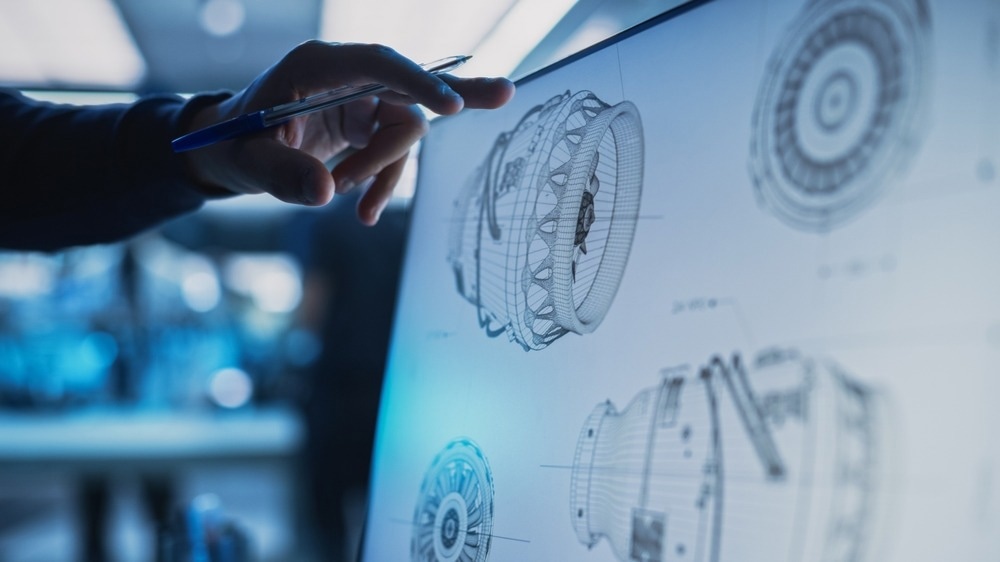 By Taha KhanReviewed by Lexie CornerJul 9 2024
By Taha KhanReviewed by Lexie CornerJul 9 2024Material science is central to the aerospace industry because components used in this field must withstand extreme conditions such as high temperatures, intense radiation, and significant mechanical stress. Material analysis tools like mass spectrometry are crucial in this context, offering precise and comprehensive analysis capabilities.

Image Credit: Gorodenkoff/Shutterstock.com
Principles and Advantages of Mass Spectrometry
Mass spectrometry measures the mass-to-charge ratio of ions by ionizing chemical compounds to produce charged molecules. A typical mass spectrometer consists of three parts: a detector, a mass analyzer, and an ion source.
The ion source ionizes the material, converting neutral molecules into ions, which are then separated by the mass analyzer via a mass-to-charge ratio. The detector measures the quantity of ions for each mass-to-charge ratio, generating a mass spectrum that provides details about the sample's structure and molecular weight.1
Mass spectrometry offers several advantages for material analysis in the aerospace industry, including high sensitivity, precise compound identification, real-time analysis capabilities, and comprehensive profiling of complex samples. For instance, it can detect minute quantities of elements and compounds, identifying traces of impurities or degradation products that might otherwise go unnoticed.
Another key feature of mass spectrometry is that it provides a unique signature for each molecule, enabling the detection of specific components and differentiation between isotopes. Certain mass spectrometers can also provide real-time results, which are useful for monitoring material behavior and performance during testing or space missions.1-3
Discover More: Microscopy & Microanalysis of Cadmium Plated Steel Landing Gear Components
Applications in Aerospace Material Analysis
Aerospace materials are subjected to extreme environments. For instance, during launch and re-entry, they experience high temperatures, creating thermal stress and potentially triggering chemical reactions that can lead to material degradation.
Space also presents the challenge of harmful radiation due to the lack of the ozone layer. Prolonged exposure to this radiation in space can cause unforeseen changes in material properties.4
Mass spectrometry helps scientists identify the breakdown products resulting from these extreme conditions, aiding in predicting material performance and developing more resilient components.
For example, researchers have used mass spectrometry to analyze outgassing products from spacecraft materials. These outgassed molecules can contaminate sensitive scientific instruments onboard and compromise mission objectives.
A 2023 study focused on using mass spectrometry to analyze outgassing products from materials used in space missions, aiming to improve contamination control by identifying and characterizing individual chemical species emitted during outgassing.5
The study reviewed a methodology applied to two materials, Black Kapton® and NuSil CV4-2946, utilizing existing outgassing data, including mass spectrometry. By coupling thermogravimetric analysis (TGA) with mass spectrometry, they successfully separated and identified the chemical species based on their mass spectra.
This method provided detailed outgassing profiles, revealing the physical laws governing the outgassing processes, such as Fickian diffusion, and enhanced the accuracy of contamination predictions for space missions.5
Industry Leaders/Look into the Market
Leading aerospace companies and research institutions are leveraging mass spectrometry to advance their material analysis capabilities. NASA, for instance, employs mass spectrometry in various programs.
The Mars Curiosity Rover carries the Sample Analysis at Mars (SAM) instrument, which includes a mass spectrometer that analyzes the Martian atmosphere and soil, identifying organic compounds and other chemicals crucial for understanding the planet's habitability and geological history.6
Case Study: Mass Spectrometer for Planetary Exploration (MASPEX)
The Mass Spectrometer for Planetary Exploration (MASPEX) exemplifies successful mass spectrometry implementation in the aerospace industry. It is a high-sensitivity, high-mass-resolution, multi-bounce time-of-flight mass spectrometer used to study the composition of celestial bodies' atmospheres.
In material science, MASPEX allows scientists to study atmospheric compositions, providing information about the materials present. For instance, it could study Europa's atmosphere for evidence of water ice, organic compounds, or other materials that could support life.7
Future Outlooks and Challenges
Mass spectrometry is continuously evolving due to advancements in instrumentation and techniques. Research and development for miniaturized and more robust mass spectrometry instruments have led to in-situ analysis, allowing real-time material characterization directly on spacecraft or during flight tests.3, 8
In the future, mass spectrometry could help develop novel materials for extreme space environments, such as those encountered on other planets or moons.
Despite its usefulness, mass spectrometry in the aerospace industry faces challenges. The initial investment in mass spectrometry equipment and technological limitations like size and weight can hinder some aerospace applications. Integrating it with other sophisticated instrumentation and analytical methods can also be challenging.
Nevertheless, the role of mass spectrometry in improving material science and aerospace applications is crucial. Its ability to conduct detailed and accurate material analysis will help develop more durable and efficient aerospace materials, leading to safer and more reliable aircraft and spacecraft.
More from AZoM: Magnesium Alloys: Trends, Applications, and New Technologies
References and Further Reading
- Arevalo Jr., R., Ni, Z., Danell., RM. (2020). Mass spectrometry and planetary exploration: A brief review and future projection. Journal of mass spectrometry. doi.org/10.1002/jms.4454
- Vanhaecke, F., Balcaen, L., Malinovsky, D. (2009). Use of single-collector and multi-collector ICP-mass spectrometry for isotopic analysis. Journal of Analytical Atomic Spectrometry. doi.org/10.1039/B903887F
- Palmer., PT., Limero., TF. (2001). Mass spectrometry in the US space program: past, present, and future. Journal of the American Society for Mass Spectrometry. doi.org/10.1016/S1044-0305(01)00249-5
- Nwankwo., VU., Jibiri., NN., Kio, MT. (2020). The impact of space radiation environment on satellites operation in near-Earth space. Satellites Missions and Technologies for Geosciences. doi.org/10.5772/intechopen.90115
- Roussel, JF., et al. (2023). Molecular characterization of polyimide film and silicone adhesive outgassing using mass spectrometry. Journal of Spacecraft and Rockets. doi.org/10.2514/1.A35465
- NASA. (N.D.) Curiosity. [Online] NASA. Available at: https://ssed.gsfc.nasa.gov/sam/curiosity.html (Accessed on June 20, 2024)
- Waite Jr, JH., et al. (2024). MASPEX-Europa: the Europa Clipper neutral gas mass spectrometer investigation. Space Science Reviews. doi.org/10.1007/s11214-024-01061-6
- Vazquez, T., Vuppala, S., Ayodeji, I., Song, L., Grimes, N., Evans‐Nguyen, T. (2021). In situ mass spectrometers for applications in space. Mass Spectrometry Reviews. doi.org/10.1002/mas.21648
Disclaimer: The views expressed here are those of the author expressed in their private capacity and do not necessarily represent the views of AZoM.com Limited T/A AZoNetwork the owner and operator of this website. This disclaimer forms part of the Terms and conditions of use of this website.